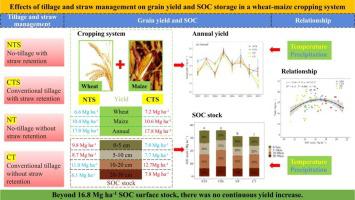European Journal of Agronomy ( IF 5.2 ) Pub Date : 2022-05-05 , DOI: 10.1016/j.eja.2022.126530 Wen-Sheng Liu 1, 2 , Wen-Xuan Liu 1, 2 , Zheng-Rong Kan 1, 2 , Jin-Sai Chen 1, 2 , Xin Zhao 1, 2 , Hai-Lin Zhang 1, 2

|
Climate change significantly impacts the prevailing climatic conditions and crop productivity. Although soil organic carbon (SOC) sequestration can mitigate global climate change, the SOC sequestration capacity and crop production under conservation tillage are unclear. This study assessed the dynamics and relationship between SOC storage and grain yield under conservation tillage over eight years. Four tillage and straw management treatments, including (i) no-tillage with straw retention (NTS, conservation tillage), (ii) conventional tillage with straw retention (CTS), (iii) no-tillage without straw retention (NT), and (iv) conventional tillage without straw retention (CT), were conducted. The results showed that the SOC content and storage in the 0–10 cm soil layer were significantly higher in NTS than in the other treatments. In contrast, SOC content and storage in the 10–30 cm layer were lower in NTS than in CTS (P < 0.05). Overall, the average SOC storage in the 0–30 cm was significantly higher in the straw returning treatment than without straw returning (P < 0.05). Moreover, SOC storage was not significantly different between NTS (35.7 Mg ha−1) and CTS (35.9 Mg ha−1). The wheat yield was lowest under NTS. Furthermore, the yield coefficient of variation under NTS was significantly lower than under CTS (P < 0.05). Maize yield was not significantly different between NTS and CTS. SOC storage in the 0–10 cm soil layer had a quadratic relationship with annual yield. These results indicate that NTS can positively sequester carbon, especially for the surface layer. However, to mitigate climate change and food insecurity, further advancements in NTS technology are required to improve crop yields and carbon sequestration capacity.
中文翻译:

耕作和秸秆管理对小麦-玉米种植系统粮食产量和 SOC 储存的影响
气候变化显着影响当前的气候条件和作物生产力。尽管土壤有机碳(SOC)固存可以缓解全球气候变化,但保护性耕作下的土壤有机碳固存能力和作物产量尚不清楚。本研究评估了八年保护性耕作下 SOC 储存与粮食产量之间的动态和关系。四种耕作和秸秆管理处理,包括 (i) 保留秸秆免耕(NTS,保护性耕作),(ii) 保留秸秆常规耕作 (CTS),(iii) 不保留秸秆免耕 (NT),和(iv) 进行了没有秸秆保留 (CT) 的常规耕作。结果表明,NTS 处理 0~10 cm 土层 SOC 含量和储存量显着高于其他处理。相比之下,P < 0.05)。总体而言,秸秆还田处理的 0~30 cm 平均 SOC 储存量显着高于未还草处理(P < 0.05)。此外,NTS (35.7 Mg ha -1 ) 和 CTS (35.9 Mg ha -1 )之间的 SOC 存储没有显着差异。NTS 下小麦产量最低。此外,NTS 下的产量变异系数显着低于 CTS 下(P < 0.05)。NTS和CTS之间的玉米产量没有显着差异。0-10 cm土层的SOC储存量与年产量呈二次关系。这些结果表明,NTS 可以积极地螯合碳,特别是对于表层。然而,为了缓解气候变化和粮食不安全,需要进一步改进 NTS 技术以提高作物产量和碳封存能力。


























 京公网安备 11010802027423号
京公网安备 11010802027423号